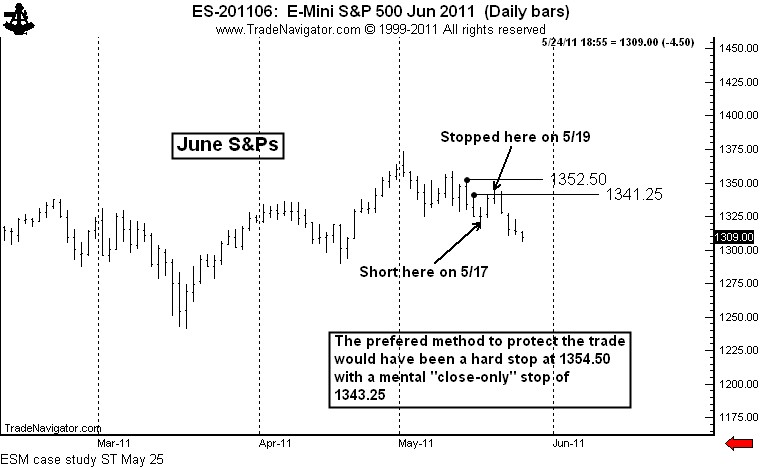Stops or no stops – a response to StockSage1
Yesterday morning I posted “Lessons from a difficult year of trading.” The post detailed three major factors contributing to my current 13 percent drawdown and nine modifications I am making to my trading plan in response to the situation. All successful traders – discretionary and systematic – are constantly on the alert for ways to improve their trading operations.
One of the nine modifications was the following:
Modify my protective stop protocol to reflect increased intraday noise
I have always believed in having protective stop orders in place at all times. I am no longer a strong advocate for this practice. I have been stopped out of too many positions only to see better exit spots within hours or days. Rather, I am now an advocate of the following protective stop protocol.
- No stops in overnight markets, including forex
- Mental stops based on closing price charts – the use of mental stops requires disciple to follow through with intentions
- Very wide actual stops (daytime session) to protect against a “worst case scenario
My friend and peer, Robert Sinn at The Stock Sage responded to my post almost immediately with an excellent piece titled, “The Evolution of a Professional Trader – Stop Loss or No Stop Loss?” Read Robert’s post here.
Robert is one smart trader and seldom misses a beat. Robert, very wisely, makes the following point:
“I believe that the use of stops is absolutely essential in short term trading. A trade should have a defined target objective which in turn requires a defined risk. It is too easy to talk oneself into moving a mental stop in the middle of a trade, therefore, using a hard stop (placed shortly after the trade is entered) is optimal over the long run.”
In a subsequent back-and-forth email exchange, Robert suggested that I more fully explain the thinking behind this modification. Great suggestion! So, here it goes.
Stops are essential in trading. Novice and emerging traders should NEVER trade without a protective stop. NEVER! I agree with Robert that using a hard stop is optimal over the long run.
The modification I am making is a rather nuanced one, as I will explain with three points and a chart example.
First, it is important for you to know that I seldom trade a leveraged futures or forex position (although the total value of all my positions combined at any given time will exceed my account value). For example, for each $1,000,000 of account value I am likely to limit a trade to four contracts of Comex Gold, 300,000 to 400,000 EURUSD or ten contracts of Corn, just to provide a few examples.
Second, I traded for decades when overnight markets were not even available – and my performance during those years was actually superior to my performance since 24-hour markets began. I can remember being awakened in northern Minnesota in the middle of a summer night by a thunder bolt, and wondering, “Is it raining in central Illinois…how will Beans open tomorrow?” I begin trading spot forex in the early 1980s, but did not pay any attention to overnight cross rates (except for the Yen) until 2007. I was in the Crude Oil market at the start of the Gulf War. I was in a Gold position on 9/11 when the Towers were hit. I survived these events just fine without 24-hour markets.
Sure, not having an order in the overnight markets will result in an occasional hit. But, I am convinced that the risk is worth it – especially considering the fact I am not leveraged in any given market.
Third, my focus on closing prices is very consistent with orders that were once common place in the good-old days of the exchange trading floor. The electronic exchange has taken flexibility away from traders. How unfortunate! For example, one order I used extensively was an “OCO,” or “one cancels the other” stop, with one component being a hard stop and other component being a “close-only” stop. Here is a real example of how this would have worked in a recent trade.
I shorted the June S&Ps at 1323 on May 17. I always place protective stops a few points above the high of the bar I use to protect a trade. The bar I used for the stop was the May 16 bar, which had a high of 1341.25. My stop was placed at 1343.25. I was stopped out on May 19.

However, my preferred order would have been to place a “close-only” stop against the May 16 bar and a hard stop against the May 13 bar. In the good-old days my stop-loss order would have read…
- “Buy 10 June S&Ps at 1353.50 stop OCO buying 10 June S&Ps at 1343.25 stop-close only, one cancels the other.”
This order strategy would have kept me in the trade. In a very real sense, this modification of my protective stop strategy is a roll-back to earlier days intended to nullify intraday noise. I will lose more money in those trades in which I am dead wrong on direction, but I will keep from getting chopped up in many more trades.
Yet, I completely agree with StockSage1 in principle that the use of stop-loss orders, all other things being equal, is a must in trading.
###





Trackbacks & Pingbacks
[…] Bob and I have had our fun with trading issues before (see here, and here and here). […]
[…] loss orders: the debate. (Peter L. Brandt, Stock […]
[…] loss orders: the debate. (Peter L. Brandt, Stock […]
Leave a Reply
Want to join the discussion?Feel free to contribute!